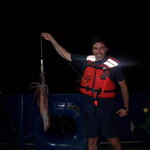Ecology & Zoology

Today's post in honor of the 2011 Cephalopod Awareness Days. October 8th is Octopus Day.
There are some weird octopuses out there, I'll grant you. The tiny-but-deadly blue-ringed octopus. The Dumbo octopus with its "ear flaps"--actually fins. But I propose that Haliphron atlanticus, the seven-arm octopus, outdoes them all.Color version (from TONMO) of Figure 1 from O'Shea 2004.
Haliphron is the largest known species of octopus--which is a rather crass way to gain attention, but the appeal of a six-footer is undeniable. But setting size aside, just look at its common name: the seven-arm…

Two items of tremendous note today, to wit:
The 2011 International Cephalopod Awareness Days begin tomorrow! It's no accident that this date also marks TONMOCON, the fourth biannual gathering of cephalopod enthusiasts. Unfortunately for me, TONMOCON IV is in Washington, D.C., and I can't make it across the country. But I will be there in squishy salty spirit!
I will, of course, be posting some truly spectacular blogs in celebration of Cephalopod Days, both here and at The Cephalopodiatrist. Stay tuned.
And the annual Ocean Bloggers for Education drive has begun! We all know, or can guess, how…

Humboldt squid have been fished in Peru for years. The government has now decided to make some new regulations, with noble intent:
The Government also aims to ensure the rational and sustainable use of the jumbo flying squid, taking into account the analysis of the biological characteristics and the stocks of this resource and of the socio-economic impact on fishermen.
One of the new rules is that all Humboldt squid caught in Peruvian waters must be intended only for direct human consumption. At first that might seem like a no-brainer, but consider that most of Peru's fisheries produce…

If you've ever wondered just what it looks like to go fishing for Humboldt squid, here's one view--a video by Philip Friedman, shot off Long Beach:
Of course, it's a bit different fishing for Humboldt squid in Mexico, where the boats are considerably smaller and the fishermen use hand lines instead of rod and reel. Here's scientist Dr. Rosa with a squid caught in the Mexican style--check out all that thick coiled line at his feet!
And it's probably different yet again in the waters off South America, but I've never been on a Chilean fishing boat. Someday, perhaps!

Koalas have a reputation of being lazy animals (see figure 1). Of course, sleeping about 19 hours a day, and spending 3 out of the 5 remaining hours eating, only adds to their ‘street rep’. But even these lazy marsupials have to mate. And that’s when it gets interesting (at least to some biologists).
Figure 1: Sleeping koala. Awww...
(Source: Wikimedia Commons, author: Dingy)
During mating season, the males bellow rather impressively (click here for an example, courtesy of the Australia Koala Foundation). Intrigued by their calls, an international team of…
October's Circus of the Spineless is up at Wanderin' Weeta's blog! Go read the horrific tale of the emerald cockroach wasp, admire the metallic teeth of the chiton, and much much more! Of course, there are some teuthological goodies as well, but my avid readers will have seen them already.
Here's something you may not have seen, though:
Tim Laman/Getty Images
Isn't that a beauty? It's one of 28 gorgeous marine life photos posted by Discovery--really, they're all worth a look. Don't tell the bigfin reef squid, but #7 is actually my favorite . . .

This is a pretty crazy story! Japanese planes spotted a fishing vessel engaged in illegal drift net fishing off the coast of Alaska, and the US Coast Guard boarded it.
The offending vessel was not registered in any nation, an unusual situation, Francis said. The crew claimed the ship, called the Bangun Parkasa, was Indonesian. But Coast Guard inquiries found no such registration with the Indonesian government, she said.
And what did they find on board the mystery ship? Thirty sharks, thirty tons of squid, and an infestation of rats.
News coverage doesn't get any more specific, so the…

Today I get a free pass on my blog, because an article I wrote about giant squid came out at Miller-McCune.com.
Conservation efforts often rally around charismatic species like the African elephant or the bald eagle. Popular affection for these “flagship” animals can be leveraged into funding and political will. But who speaks for the 95 percent of Earth’s inhabitants without a backbone? No worm has the rock-star appeal of a Bengal tiger.
Enter the giant squid.
Go read the rest!
This story has an interesting footnote. According to the editor of Miller-McCune,
Right now "giant squid" is…

A few months ago, the news of a tool-using fish was spread (for more information about it, as well as about tool-use in other animals and the definition of tool-use, check this post). Now, a closely related species, the orango-dotted tuskfish (Choerodon anchorago), has also been observed using tools. More specifically, the fish cracked bivalves using a rock as anvil. And it's been filmed.
ReferenceBernardi, G. (2011). The use of tools by wrasses (Labridae). Coral Reefs. Published online 20…
Drawn by the newly arrived throngs of Humboldt squid in Southern California, an underwater photographer hopped in the water with them to snap some photos.
They're smallish for Humboldts, but note how he's grabbing this one--and he didn't get bitten, not even a little bit!
Of course, Schwartz was not without trepidation, especially when he snapped this shot:
I'm not a squid expert but it seems to be an aggressive stance; check out how the tentacles are thrust forward at me. It looks like it was waiting to strike! Someone who has dove with them referred to this as "attack mode" but again, I'm…